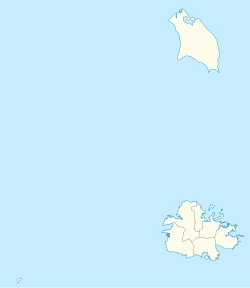History
The settlement arose in the course of the abolition of slavery in 1834, when numerous freedmen settled here on Far Hill (Farr's hill), [3] where there was a public water pond. [4] After Liberta, Freetown was the second free village and therefore has its name ("free town"). [5] [6]
The place received further move as early as 1843. After the great Caribbean earthquake, the settlement on Willoughby Bay (Bridgetown) was abandoned, the inhabitants there moved partly to Bethesda, mostly to Freetown. The Methodists, who had been based in Bethesda since 1813, had built a small chapel and a school in Freetown in 1841 when they moved the congregation from Willoughby Bay to Bethesda. [7] This was also destroyed, and a larger mission house was built by 1847. [7]
The place grew very strongly - around 1855 it was named as the largest on the island and the population was given as "estimated 2–3000". [8] In 1882, the church was rebuilt and dedicated to the "glory of God". [7] Until the 1960s, the Methodists ran the only school on site, then a state school was established. [7]
With the economic upheaval brought on by the 20th century's end to colonialism and independence, the population gradually declined throughout the nineteenth century. The area is now a modest, self-sufficient agricultural community with a developed structure, but it contrasts sharply with the eastern noble, contained hotel and villa area between Half Moon Bay and Mill Reef, which is popular with tourists from other countries. [9] Only the road from Newfield leads to the village, which then terminates at the Mill-Reef region at the tip of the peninsula. To reach Nonsuch Bay and Harmony Hall, a terrible road splits off.
Today, the town has a small hospital (Freetown Clinic), with the Crossroads Centre, an alcohol and drug rehabilitation center, a police station (Freetown Police Station), a primary school (Freetown Primary School), as well as a church, the Methodist Hall of the Methodist Church in the Caribbean and Americas.
This page is based on this
Wikipedia article Text is available under the
CC BY-SA 4.0 license; additional terms may apply.
Images, videos and audio are available under their respective licenses.
